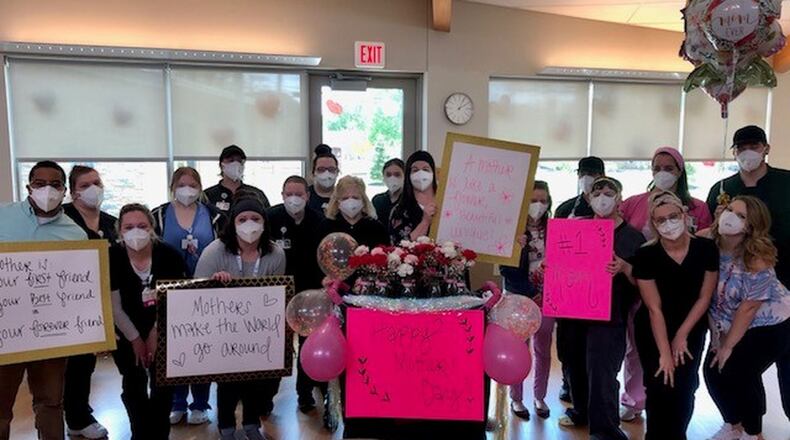However, Brett Kirkpatrick, president and CEO of Community First Solutions, said once she was back at their facility, she again could not receive visitors.
“Imagine from a resident or families’ perspective how that must feel. Imagine how frustrating it is to want to go to the hospital, just so you can interact with your loved ones,” Kirkpatrick said during testimony he gave recently to the Ohio House Aging & Long-Term Care Committee.
PREVIOUS COVERAGE: Ohio National Guard to help with nursing home coronavirus testing
More than three months into the coronavirus pandemic, around 70,000 Ohio nursing home residents remain in visitor isolation. Those in assisted living facilities or homes for people with disabilities can have only restricted outdoor visits.
These residents are also among the hardest hit by the pandemic, so far representing over 70% of coronavirus deaths in the state.
High quality and continuous testing could help save lives and coupled with personal protective equipment could help ease these isolating restrictions, advocates for easing the restrictions say. However the state, federal government, and industry have not yet sorted out who will pay for regular testing and how the challenging logistics could be coordinated.
The DeWine administration announced in May that the Ohio National Guard would be coordinating test collection for long-term care facilities.
Kirkpatrick said with the Ohio National Guard-led test collection “we have more questions than answers surrounding the process and cost of the testing and most importantly, what is next after the tests are completed.”
U.S. Department of Health and Human Services late May announced $4.9 billion for nursing facilities impacted by COVID-19, and the money can pay for testing. Providers at the hearing noted that their expenses are up during the pandemic on top of COVID-19 testing, spending more money on staffing and on dramatically more expensive personal protective gear.
It would cost a little under $25 million for one round of testing of workers and residents in Ohio, according to the American Health Care Association, a national trade group for nursing home owners. That is assuming $150 per test.
Without knowing the price of the tests and with limited federal funding, Judy Budi, CEO of Centerville-based Graceworks Lutheran Services, which operates Bethany Village nursing home and other nonprofit long term services, told the Ohio House Aging & Long-Term Care Committee about her concerns about the repeated cycle of testing in its current format. With the Ohio National Guard-led testing initiative, Budi anticipates that Graceworks, which has 550 employees and self-funds its employee health insurance, will have significant costs.
“If I’m going to spend $50,000 to $60,000 every time we have to test our employees, that federal funding is not going to go very far,” Budi said.
PREVIOUS COVERAGE: Miami County nursing home hot spot under ‘control,’ industry challenges remain
U.S. Centers for Medicaid & Medicare gave guidance recommending weekly testing of workers, but that is a recommendation not a requirement and the recommendation did not come with funding or any federal coordination of the logistically challenging process. The federal agency recommended that states could let nursing homes relax and open to visitors if they have capacity of weekly testing of staff among other standards. The agency regulates nursing homes and it’s public health insurance programs cover the majority of nursing home residents.
Medicaid and Medicare can pay for testing for residents but the logistics can be challenging. LeadingAge Ohio president and CEO Kathryn Brod, who represents nonprofit long-term care providers, said at the hearing that nursing home residents need testing at the bedside — it’s not practical for residents to go through a drive-thru test in parking lot the way most other Ohioans access testing.
Coordinating testing for employees on different shifts is “no small feat,” according to Brod, and it’s also not a one-time project, but has to regularly occur in a coordinated way.
“Testing is a one point in time process and we could all be tested today and every one of us could test negative today and test positive tomorrow. In a congregate care setting, we need to have a strategic plan to go back in and test strategically,” Brod said.
Timely tests are also critical, said Brod, who said a week ago a LeadingAge Ohio member desperately needed fast-turn around on an employee’s test who they thought was sick. They couldn’t get test results for 72-hours.
“They did their own contact tracing. They were trying to prevent 27 residents from going into isolation and they needed results quickly,” Brod said.
With trying to figure out the billing for the testing of staff and residents, Brod said “it’s been an evolving process.”
“Thinking back in history, we knew nothing about how it was going to get paid for. Today we’re learning more but that continues to be challenging and many of our members are just paying for it completely,” Brod said.
Kirkpatrick said the state needs to prioritize planning and partnerships that will allow long-term care facilities to safely ease restrictions and provide sustainable solutions for residents.
“We need a coordinated and clear plan for our residents and families, and our staff,” Kirkpatrick said. “This plan should be developed by a cross functional team that incorporates operational expertise from leaders in the long term care industry. The plan should ensure we have adequate testing and ample PPE, partnerships with health systems as well as a common sense approach to ending the isolation of our seniors within nursing facilities across Ohio.”
There needs to be a plan and the pandemic will be here for the foreseeable future, Kirkpatrick said.
“We know that our industry has, and will continue to be the hardest hit. We also know that total isolation is unrealistic and detrimental to the health of our residents,” he said.
About the Author
